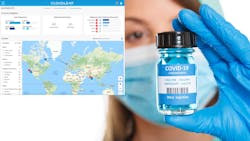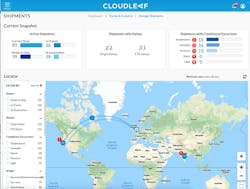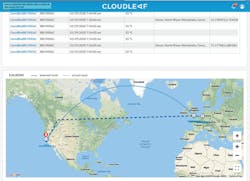Sensor-Based IoT Platforms Monitor Vaccines at the Frontline
At a Glance:
- The safe preservation of vaccines in temperature-controlled environments during storage and transportation is tied to IoT sensors.
- Providing a “digital visibility platform” across the cold chain, Cloudleaf, a software-as-a-service (SaaS) company, is at the forefront of vaccine shipment.
- Mahesh Veerina, CEO, Cloudleaf, explains how lessons from the “pandemic visualization exercise” will spill over into other industries.
The COVID-19 vaccine rollout has highlighted the need for visibility across the cold chain. Knowing where shipments are, what condition vaccines are in and having reliable ways to track expected arrival times were notable risks.
If we assume global vaccine coverage of 10 billion doses, vaccine distribution would require an estimated 200,000 movements by pallet on 15,000 flights, according to International Air Transport Association research.
Given the scale and magnitude of the vaccine rollout, and the reality that COVID-19 vaccines were temperature-sensitive, overcoming logistical hurdles would be unlikely without the use of monitoring technology to secure the cold chain. So contends Mahesh Veerina, CEO of San Francisco-based Cloudleaf, which provides SaaS using sensors to track the location, temperature, humidity, vibration and acceleration.
Moreover, the emergence of faster-spreading virus variants, coupled with a strained vaccine distribution effort, highlights the criticality of sensors and their role in providing real-time digital visibility. Sensors can monitor the expedition from the moment the vaccine leaves the manufacturer and enters the distribution chain until it is administered to the individual’s arm, said Veerina, whose company has been at the forefront of vaccine movement.
Enabling Real-Time Visibility
Generally, a quarter of vaccines are degraded by the time they reach their destination. Losses associated with excursions (when a vaccine is exposed to temperatures outside the recommended range) add up to about $34.1 billion annually. These costs include lost product cost, wasted logistics, root cause analysis, labor and clinical trials.
To waylay some of these costs, Veerina said, sensors are used in IoT systems to ensure not only that vaccine temperatures are held constant, but can also verify the stability of the vaccines along the storage, transport and distribution chains. He added that the history of using sensor technology to help in transporting vaccines is tied to strict FDA regulations and established temperature bands. Storage and handling guidance for COVID-19 vaccines approach −70°C, but most vaccines remain viable within +2°C to +8°C.
Sensors are an integral part of Cloudleaf’s end-to-end, real-time digital visibility platform. “Right at a pallet level or a case level, or even an item level, you have these sensors attached to products,” Veerina said. The sensors accompany the vaccines as they move through warehouses, tracking multiple handlers as they are distributed in the supply chain—via trucks, planes and logistics service providers and handlers.
“As it moves [through the system], you want to know the precise conditions it has moved through,” Veerina explained. “If you look at a lot of life-saving drugs, it’s very important from a patient safety perspective. If the specific drug doesn’t get there on time, you have to make alternate arrangements to get it on time.
“[Cloudleaf] can provide that real-time visibility,” he continued. “Where is it? What condition is in? Is it in compliance? It’s very important for the drug manufacturer to monitor the quality for regulatory purposes. We provide all these intelligence and insights into the movement of vaccines through the supply chain.”
Cloudleaf’s digital visibility platform uses cloud, digital twin, AI/ML and IoT technologies to deliver continuous visibility and intelligence. IoT sensors are integrated in the solution’s ecosystem so users can access granular, holistic and real-time insights into the location and condition of assets.
The platform provides about 400 APIs, is linked into existing ERP systems and integrates with warehouse management systems in order to extract data and see where orders are generated or where shipments are created. “You can literally light it up within a matter of hours to a day, and it’s a matter of engaging these sensors,” said Veerina.
In delivering the COVID-19 vaccine, cold chain containers are fitted with IoT sensors, which feed into a database, explained Veerina. By combining real-time events from the sensors, business processes, disruptions and risks, the platform uses Bluetooth to continuously track, transmit, visualize and analyze sensory signals at the site of the vaccine. Users can establish rules to send alerts when thresholds are met or when locations are reached along the supply chain.
“When something is going wrong, customers can start intervening in the middle of the process and provide incident response management,” Veerina noted. “We literally become an operating platform for these customers through the journey of vaccines.”
Mass-Distribution Experiment
The U.S. ships about 150 million flu vaccines in a typical year. These vaccines are mainly distributed via the private sector. In contrast, delivering COVID-19 vaccines is a monumental effort, as there are billions of COVID-19 vaccines being moved around.
Take as an example the Pfizer-BioNTech COVID-19 vaccine, which is intended to be given in two doses 21 days apart and must remain frozen during shipping. Pfizer Inc. and its German partner, BioNTech, will potentially deliver two billion doses globally by the end of 2021. To date in 2021, Pfizer has shipped on average five million doses per week in the U.S. The company expects to deliver a total of 150 million doses of the vaccine by the end of July 2021.
Ahead of each COVID-19 vaccine shipment schedule, a lot of arrangements are made, including considerations for how to move from manual to automated processes. “This is where sensors and real-time visibility platforms make a difference,” Veerina said. “In my view, the pandemic, unfortunate as it is, has accelerated this whole digitization process by at least three to five years, if not more. There are a lot of learnings because it’s a multi-stakeholder environment.
“You have the bulk producers, the vaccine makers, the fill-and-finish operations, the logistics service providers like trucks and planes, and the final leg—the last mile delivery,” he added. “With multiple handling spots, geofencing, getting real-time data, taking out manual processes and automating through sensors, and giving real-time visibility on where it is and whether any intervention is needed to save the vaccines and save lives, this is now an irreversible process…Unfortunately, we will have to deal with this situation for a while.”
Veerina pointed out that while pivoting is never easy, stakeholders learned to leverage new digital tools to reduce losses in the supply chain and enable the effective delivery of drugs. “We’re definitely moving away from manual processes and will spend time on more automation and optimizing digital processes,” he said. “We are on the right path here. We’re still in the early days, and a lot more digitization needs to be happening across many processes.”
To date, Cloudleaf is behind the movement of close to 200 million vaccine doses, and the company has learned a lot about streamlining its local and global processes. “We are in a historic moment,” Veerina said. “We were kind of in the right time, right place in one sense from Cloudleaf’s perspective, as this pandemic unfolded. Again, it’s a global phenomenon. How do you move these [vaccines], especially in some countries where the infrastructure to keep vaccines at temperatures of −70°C is not viable? Monitoring the packages has become very important.”
Sensors taught us a lot in the cold chain context, but the lessons are broadly applicable, noted Veerina. He pointed out the pharma/life sciences segment, where nearly $350 billion worth of cold chain temperature control logistics takes place, and where $35 billion is wasted every year.
“Clinical trials, blood plasma-based drugs, cell and gene therapy…all of these need exacting compliance requirements and temperature control and so on,” he said. “All of these subject areas will be beneficiaries of the vaccine rollout process, by learning how to automate, how to extract data from the sensors, how to build intelligence, and predictive and prescriptive algorithms to reduce losses in the supply chain and save more lives.”
Lessons from the current pandemic visualization exercise will spill over into many other industries, too. Down the line, sensors will shrink to the size of small postage stamps, and the industry will apply it to lower-cost products for item-level visibility; it further opens up opportunities for inventory intelligence for deliveries. “With the boom of e-commerce, those applications will be very big,” said Veerina. “We’re very excited about what could happen in this space, we’re on the forefront of that.”
About the Author

Rehana Begg
Editor-in-Chief, Machine Design
As Machine Design’s content lead, Rehana Begg is tasked with elevating the voice of the design and multi-disciplinary engineer in the face of digital transformation and engineering innovation. Begg has more than 24 years of editorial experience and has spent the past decade in the trenches of industrial manufacturing, focusing on new technologies, manufacturing innovation and business. Her B2B career has taken her from corporate boardrooms to plant floors and underground mining stopes, covering everything from automation & IIoT, robotics, mechanical design and additive manufacturing to plant operations, maintenance, reliability and continuous improvement. Begg holds an MBA, a Master of Journalism degree, and a BA (Hons.) in Political Science. She is committed to lifelong learning and feeds her passion for innovation in publishing, transparent science and clear communication by attending relevant conferences and seminars/workshops.
Follow Rehana Begg via the following social media handles:
X: @rehanabegg
LinkedIn: @rehanabegg and @MachineDesign




